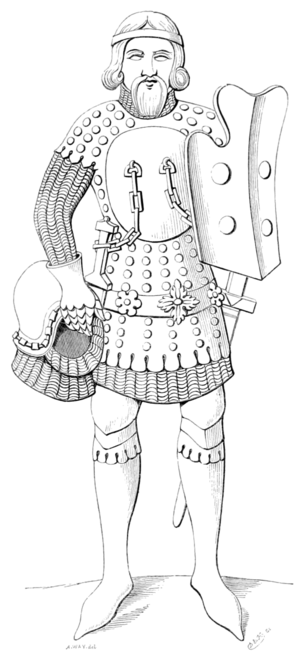armorial jupon, similar in general form, which was worn in England over plate-armour towards the close of the fourteenth century, for we here perceive attached to it a plastron, or breast-plate, with appended chains.
This remarkable defence may be regarded as the primitive fashion of plate-armour for the upper part of the body, which led the way to the adoption of the more complete defence termed by Chaucer a pair of plates[1]. These figures also present early examples of the escutcheon, termed à bouche, that is, formed with an aperture at the dexter angle above, through which the spear might pass, whilst the body was not deprived of the protection of the shield. It may also deserve notice how carefully the throat was protected, for besides the camail appended to the bacinet, the high collar of the hauberk formed a complete defence for the neck; this was probably a provision against the risk of the point of a lance or sword finding its way under the camail.
- ↑ Sonic kind of breast-plate had been used as early as the reign of Henry II., as may be gathered from the lines of William le Breton, who describing a tilting match, in which Richard Cœur de Lion, at that time earl of Poictou, took part, says, that in the fury of the encounter the ashen lance pierced through shield, gamboison, and breast-guard, wrought with triple tissue; so that at last "vix obstat ferro fabricata patena recocto," the little plate of proof scarce could resist the thrust. The pair of plates were used in England as early as 1331. It appears by the Inventories of the Exchequer that in that year Edward III. ordered restitution of the armour of Roger, earl of March, to his son Esmon de Mortemer; and amongst the items occur "une peire des plates covertz de rouge samyt. vj. corsets de feer," &c. Possibly the small breast-plates represented as worn by the Bamberg warriors were termed "corsets."

